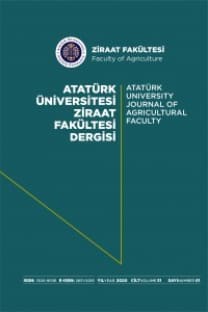Some biological observations on Mamestra brassicae (Linnaeus, 1758) (Lepidoptera: Noctuidae), an important cabbage pest in Erzurum, Turkey
Erzurum' da önemli bir lahana zararlısı Mamestra brassicae (Linnaeus, 1758) (Lepidoptera: Noctuidae)' nin biyolojisi üzerinde bazı gözlemler
___
- Anonymous, 2002. Agricultural Structure (Production, Price, Value) 2000.- Başbakanlık Devlet İstatistik Enstitüsü Matbaası, Ankara, Turkey (in Turkish).
- Avcı, Ü., Özbek, H., 1990. Cabbage lepidopterous pests and their parasitoids in Erzurum. Proceedings of the Second Turkish National Congress of Biological Control 12-14 February 1990, Ankara, Turkey, pp. 319-330 (in Turkish).
- Başar (Onursal), S. S., Uğur, A., 1995. Investigations on some morphological and biological aspects of Mamestra brassicae (L.) (Lepidoptera, Noctuidae) in laboratory conditions. Türk. Entomol. Derg. 19: 267-276 (in Turkish).
- Birch, M. C, Lucas, D., White, P. R., 1989. The courtship of the cabbage moth, Mamestra brassicae (Lepidoptera: Noctuidae), and röle of male hairpencils. J. Insect Behav. 2: 227-239.
- Doğanlar, M., Özbek, H,, Ecevit, O., Yüksel, H., 1981. Some species of Lepidoptera fron) Eastern Anatolia. Bit. Kör. Bult, 21: 155-172 (in Turkish).
- Johansen, N. S., 1997. Mortality of eggs, larvae and pupae and larval dispersal of the cabbage moth, Mamestra brassicae, in white cabbage ir south-eastern Noiway. Entomologia Elxperimentalis et Âpplicata 83: 347-360.
- Kazimirova, M., 1996. Influence of larval crowding and mating on lifespan and fecundity of Mamestra brassicae (Lepidoptera: Noctuidae). Eur. J. Entomol. 93: 45-52.
- Klingen, I., Meadow, R., Aandahl, T., 2002. Mortality of Delia floralis, Galleria mellonella and Mamestm brassicae treated with insect pathogenic hyphomycetous fungi. J, Appl. Ent. 126:231-237.
- Noldus L.P.J.J., R.P.J. Potting, 1990. Calling behaviour Mamestra brassicae: effect of age and photoperiod. Entomologia Experimentalis et Applicata 56: 23-30.
- 0gaard, L., 1983. The cabbage moth (Mamestra brassicae (L.), Lepidoptera, Noctuidae), Development in Denmark illustrated by simple simulation. Entomologiske Meddelelser 50: 36-46.
- Pierce, L. C, 1987. Vegetables (Characteristics, Production, and Marketing). John Wiley and Sons Inc., Canada.
- Popova, T.; 1993. A study of antibiotic effects on cabbage cultivars on the cabbage moth Mamestra brassicae L. (Lepidoptera: Noctuidae). Entomol. Rev. 72: 125-132.
- Poppy, G. M., Birch, M. C, 1994. Evidence of the eversion of Mamestra brassicae (Lepidoptera: Noctuidae) hair-pencils during courtship^. Insect Behav. 7: 885-887.
- Rojas, J.C., Wyatt T. D., Birch, M. C, 2000. Flight and oviposition behavior toward different host plant species by the cabbage moth, Mamestra brassicae (L.) (Lepidoptera: Noctuidae). J. Insect Behav. 13: 247-254.
- Rojas, J. C, Wyatt, T. D., Birch, M. C, 2001. Oviposition by Mamestra brassicae (L.) (Lep.. Noctuidas) in relation to age, time of day and host plant. J. Appl. Ent. 125:161-163.
- Tozlu, G., Hayat, R., Güçlü, Ş., Güîtekin, L, 1998. Insect pests of cabbage in Erzurum province. The Second Vegetable v Symposium, 28-30 September 1998, Tokat, Turkey, pp. 344-348 (in Turkish).
- Tozlu, G., Gültektn, L., Hayat, R., Güçlü, Ş., 2002. Studies on the natural enemies of cabbage pests in Erzurum. Proceedings of the Fifth Turkish National Congress of Biological Control (Eds., H. Özbek, Ş. Güçlü and R. Hayat), Faculty of Agriculture, Atatürk University, Erzurum, Turkey, pp. 227-235 (in Turkish).
- Turnock,W. J., Cad, K. P., 1995. Evaluation of the palaearctic Eurithia consobrina (Diptera: Tachinidae) as a potential biocontrol agent for Mamestra conflgurata (Lepidoptera: Noctuidae) in Canada. Biocontrol Science and Technology 5: 55-67.
- ISSN: 1300-9036
- Yayın Aralığı: 3
- Yayıncı: -
Konukçu-Patojen İlişkisinde Model Bir Bitki: Arabidopsis thaliana
Bor Bileşikleri ve Tarımda Kullanımı
Levent GÜLTEKİN, Göksel TOZLU, Şaban GÜÇLÜ, Rüstem HAYAT
Dondurulmuş Gıda Tüketimini Etkileyen Sosyo-Ekonomik Özelliklerin Belirlenmesi; Erzurum İli Örneği
Murat KÜLEKÇİ, Abdulkadir TOPALOĞLU, Adem AKSOY
Bilal CEMEK, Mustafa GÜLER, Hakan ARSLAN
Erken ve Geç Biçilmiş Çayır Otu ile Beslenen Siyah Alaca Danaların Büyüme Performansı Özellikleri
Ömer MENTEŞE, Leyla TURGUT, Olcay GÜLER, Mete YANAR, Naci TÜZEMEN, Mustafa TAN, Binali ÇOMAKLI
Gökhöyük Tarım İşletmesi Topraklarının Kalite Durumlarının Değerlendirilmesi
Mustafa USLU, Murat Güven TUĞAÇ, Aynur DİLSİZ
Murat ATASEVER, Murat ATASEVER, Gülşah ADIGÜZEL, Gülşah ADIGÜZEL
